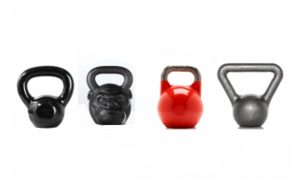Kettlebells
Where do you even start when it comes to making a kettlebell purchase? How do you know if you’re going too light or too heavy? Do you just go into a gym and start hefting crap around? You see other people lifting and you wonder, wow, how did they get so good at lifting bells.
If you’re not sure, well, you’re not alone. Kettlebell lifting, for the uninitiated, seems intimidating. But its simpler than you might believe. Because of the popularity of CrossFit, kettlebell lifting is becoming more widely known to the average Joe and bells are more accessible in fitness stores for customers to purchase. Let’s break it down some:
A pood is a Russian measurement of weight and is 16.38 kilograms. So, 1 Pood = 16 KG kettlebell, 1.5 Pood = 24 KG kettlebell and 2 Pood = 32 KG kettlebell.
The next thing to know is about bells is there are competition specs and non competition specs. Marty uses steel instead of cast iron in his competitions. A bell competitor is looking for a particular kind of weight, handle width, ball diameter, handle shape and a specific distance from the top of the ball to the top of the handle. Marty explains this in the video. The need for these particular specs is the competitor can rest the bell and handle on his or her forearm in such a way that it can be chambered and rechambered without slipping.
Competition bells aren’t always used by competitors but they are preferred because a greater attention to quality is usually given to it by the manufacturer. However, there are many brands that make good bells; find something you can manipulate well. Wider bell bases allow the bell to be placed on the ground without rolling over, and a good non-slip handle allows obviously good hand gripping.
Okay, let’s get into the bell.
First you have to ask yourself, “What do I intend to do with the bell?” There are ballistic movements and their are grinds. Ballistic movements are explosive. You see this done in a lot of kettlebell competitions such as swings, cleans and snatches. Grinds are usually workout movements done to strengthen the body (on top of doing all of the other lifts) and these are not so explosive; Turkish Get-Ups, Overhead Presses and Windmills are some that are popular and effective.
Not only do bells come in different weights but they come in different shapes. The smaller bells come in 8 KG (18 lbs), or 12 KG (26 lbs) weights and these are excellent for pressing overhead in movements that are controlled such as the Turkish Get-Ups. Heavier sizes are good for ballistic lifting. Unfortunately most people go a bit too heavy when instead they should have purchased a more reasonable weight, and for that matter, a good shape. In the video above Marty is using a competition shaped bell. The bell has a handle and bell shape that is most suited for utilitarian use; there aren’t faces decorating the bell or odd handle shapes that make it more difficult to manipulate.
Marty is known to do a ballastic swing a 90 lb bell with ease. If you practice long enough and get strong enough with a bell, then doing this is totally conceivable. For someone starting out, it is best to go with either a 16 KG (35 Lbs) or a 20 KG (44 Lbs) kettlebell for ballistic movements.
Once you are able to manipulate a 20 KG bell easily then its time to move up to the 28 KG (62 lbs). Start off slow, be able to control your movements, and move onto to larger/heavier bells if you are able to control the weight throughout the entire range of movement.
Look for a kettlebell handle that can be gripped no matter what part of the grip you place your hand on. Some bells have a triangular shape but this is impractical for doing many competition movements but they do have their pluses. For example, a triangular shaped handle, is excellent for building good hand grip and forearm strength because you can hold it so many different ways.
Try to purchase a kettlebell that has been molded completely. If you purchase a bell with a handle that was welded post mold then choose a good kettlebell. Kettlebells with handles added by welding might have rough areas that cause friction to the hand and irritates it after doing higher amounts of reps.
Follow our regular channel at Spotterup on YouTube
Follow our WEBSITE
Follow on Instagram
Visit our STORE
*The views and opinions expressed on this website are solely those of the original authors and contributors. These views and opinions do not necessarily represent those of Spotter Up Magazine, the administrative staff, and/or any/all contributors to this site.

